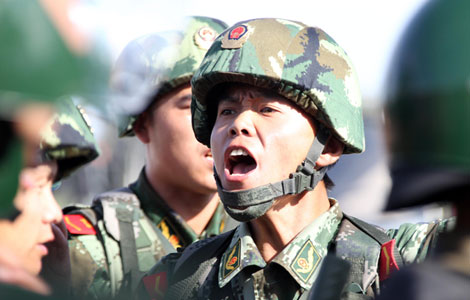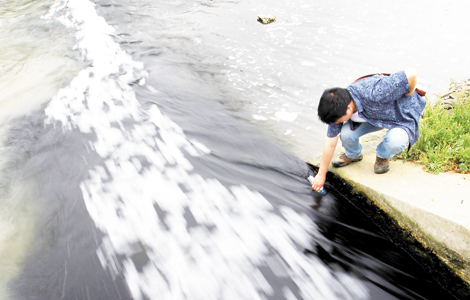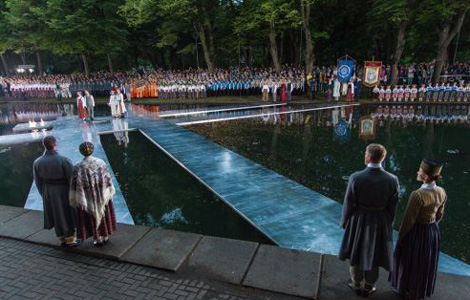Tokyo monitors Chinese fleet
Updated: 2013-07-04 02:14
By ZHAO SHENGNAN (China Daily)
|
||||||||
A Chinese fleet passed through the strategic Tsushima Strait into the Sea of Japan on Wednesday and will join Russia's Pacific fleet this week for China's largest-ever naval drill with a foreign partner.
In response to the movement by the Chinese fleet on the high seas between Japan and South Korea, Japan's Self-Defense Forces sent P-3C surveillance aircraft and a Shimakaze missile destroyer to watch the fleet and later released photographs of the warships, media reported.
The Chinese fleet consists of four destroyers, two guided-missile frigates and a supply ship.
Observers said China made a legal and reasonable choice to join Russia for the "Joint Sea 2013" exercises, scheduled from Friday to July 12 at Peter the Great Bay, near Vladivostok.
The Tsushima Strait is the best route for a Chinese fleet going to Russia because of its legitimacy as a sea route based on international and Japanese law, favorable ocean currents there and international custom, said Xing Guangmei, a Beijing-based military law expert.
The strait is the eastern channel of the Korea Strait, connecting the Sea of Japan and the East China Sea. Its location has made it an important route and is Japan's strategic fortress.
According to United Nations Convention on the Law of the Sea, ships enjoy freedom of navigation in related waters of the strait. Therefore, it is not compulsory for ships crossing the strait to inform the Japanese government in advance, she said.
"It is not surprising for the Chinese fleet, just like many foreign ships, to cross the strait, one of the busiest waterways in the world," Xing said. "It's a more-convenient choice than the other channels."
She added, "There are no threats that need Japan's special attention, as the fleet is just passing through, while Japan is the gatekeeper of the strait."
Li Shuyin, an expert on Central Asian and Russian military studies with the People's Liberation Army Academy of Military Sciences, said Japan plays up every Chinese naval movement, including regular exercises, in the Pacific. Japan aims to defame China's military and seeks to boost its own military development, which is restricted by Tokyo's postwar constitution.
"But as the joint exercises between China and Russia have become regular and normalized, the Chinese navy is likely to continue crossing the strait in the future," Li said. The close distance between China's and Russia's Pacific fleets gives them similar security challenges and incentives to cooperate, Li added.
Eleven warships, a submarine and three planes from the Russian navy will join drill.
The two navies will practice liberating a ship seized by pirates and will conduct search-and-rescue operations, Roman Martov, a spokesman for Russia's Pacific Fleet, told the Itar-Tass news agency on Tuesday. They will also practice organizing joint air, anti-submarine and anti-ship defenses.
Russia and China have regularly held joint naval drills since 2005 within the framework of the Shanghai Cooperation Organization. However, the upcoming drill will be the second exercise conducted by the two countries outside the organization. The first was in the Yellow Sea in April 2012.
Fang Fenghui, the PLA chief of the general staff, and his Russian counterpart, Valery Gerasimovon, also announced on Monday that "Peace Mission 2013", a joint anti-terrorism military drill between China and Russia, will be in Russia's Chelyabinsk from July 27 to Aug 15.
"The joint drill conducted by the two militaries of China and Russia do not target any third party," Fang said. "Their aim is to deepen cooperation between the two militaries in the training field, boost capacity in coordinating military activities and serve the purpose of safeguarding regional security and stability."
Xinhua and AP contributed to this story.

 July 4 in Prescott: Balance of grief, patriotism
July 4 in Prescott: Balance of grief, patriotism
 Jubilant crowds celebrate after Mursi overthrown
Jubilant crowds celebrate after Mursi overthrown
 Growth slowing for services
Growth slowing for services
 Venezuela eyed as Snowden seeks asylum
Venezuela eyed as Snowden seeks asylum
 Anti-terror drill staged in Xinjiang
Anti-terror drill staged in Xinjiang
 Memorial service held for 19 Arizona firefighters
Memorial service held for 19 Arizona firefighters
 Canada vigilant after terror plot
Canada vigilant after terror plot
 Beckhams' star power shines
Beckhams' star power shines
Most Viewed
Editor's Picks

|

|

|

|

|

|
Today's Top News
Obama, Merkel agree talks on surveillance program
Filipino executed for drug trafficking
Obama orders US to review aid to Egypt
Snowden still in Moscow
China urges more efficient uses of fiscal funds
Egypt army topples president Mursi
China to strengthen ties with Uganda
Frankfurt aims to be key yuan center
US Weekly

|

|







